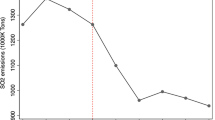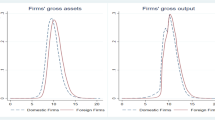Abstract
A qualitative response model is applied to study the relationship between environmental regulations and plant exit. The data set is Norwegian panel data for establishments in three manufacturing sectors that have high shares of units which have been under strict environmental regulations. In two of the sectors, the estimated exit probability of regulated establishments is, ceteris paribus, only one third of the exit probability of non-regulated establishments. We also find that the probability to change regulation status from being non-regulated to become regulated depends significantly on economic factors. In particular, establishments with weak profitability had the highest probability to come under environmental regulation.
Similar content being viewed by others
References
Audretsch, D. B. (1995), 'Innovation, Growth and Survival', International Journal of Industrial Organization 13, 441–457.
Audretsch, D. B. and J. Mata (1995), 'The Post-Entry Performance of Firms: Introduction', International Journal of Industrial Organization 13, 413–419.
Barbera, A. J. and V. D. McConnell (1986), 'Effects of Pollution Control on Industry Productivity: A Factor Demand Approach', Journal of Industrial Economics 35, 161–172.
Brännlund, R., R. Färe and S. Grosskopf, (1995), 'Environmental Regulation and Profitability: An Application to Swedish Pulp and Paper Industry Mills', Environmental and Resource Economics 6, 23–36.
Conrad, K. and C. J. Morrison (1989), 'The Impact of Pollution Abatement Investment on Productivity Change: An Empirical Comparison of the U. S., Germany, and Canada', Southern Economic Journal 55, 689–698.
Cramer, J. S. (1991), The Logit Model. An Introduction for Economists. London: Edward Arnold.
Davidson, R. and J. G. MacKinnon (1993), Estimation and Inference in Econometrics. Oxford: Oxford University Press.
Deily, M. E. and W. B. Gray (1991), 'Enforcement of Pollution Regulations in a Declining Industry', Journal of Environmental Economics and Management 21, 260–274.
Doms, M. E., T. Dunne and M. J. Roberts (1995), 'The Role of Technology Use in the Survival and Growth of Manufacturing Plants', International Journal of Industrial Organization 13, 523–542.
Engle, R. F., D. F. Hendry and J.-F. Richard (1983), 'Exogeneity', Econometrica 51, 277–304.
Fahrmeir, L. and G. Tutz (1994), Multivariate Statistical Modelling Based on Generalized Linear Models. New York: Springer.
Gollop, F. M. and M. J. Roberts (1983), 'Environmental Regulations and Productivity Growth: The Case of Fossil-Fueled Electric Power Generation', Journal of Political Economy 91, 654–674.
Golombek, R. and A. Raknerud (1997), 'Do Environmental Standards HarmManufacturing Employment?' The Scandinavian Journal of Economics 91(1), 29–44.
Golombek, R. and A. Raknerud (1995), Environmental Regulations and Manufacturing Employment- A Study on Norwegian Data. Memorandum from the Department of Economics, University of Oslo, No. 17, 1995.
Gray, W. B. and R. J. Shadbegian (1993), 'Environmental Regulation and Manufacturing Productivity at the Plant Level', NBER Working Paper # 4321.
Greene, W. H. (1993), Econometric Analysis, Second Edition. New York: Macmillan.
Johansen, L. (1959), 'Substitution versus Fixed Production Coefficients in the Theory of Economic Growth: A Synthesis', Econometrica 27, 157–176.
Jorgenson, D. W. and P. J. Wilcoxen (1990), 'Environmental Regulation and U. S. Economic Growth', RAND Journal of Economics 21, 314–340.
Maddala, G. S. (1983), Limited-Dependent and Qualitative Variables in Econometrics. Cambridge: Cambridge University Press.
McFadden, D. L. (1984), 'Econometric Analysis of Qualitative Response Models', Ch. 24 in Z. Griliches and M. D. Intrilligator, eds., Handbook of Econometrics, vol. II. Amsterdam: North-Holland.
Porter, M. E. (1990), The Competitive Advantage of Nations. New York: The Free Press.
Porter, M. E. (1991), 'America's Green Strategy', Scientific American, April 1991, 168.
SFT (1987), 'Control of Manufacturing Emissions, Mimeo, January 13, 1987, The State Pollution Control Authority.
Author information
Authors and Affiliations
Corresponding author
Rights and permissions
About this article
Cite this article
Biørn, E., Golombek*, R. & Raknerud, A. Environmental Regulations and Plant Exit. Environmental and Resource Economics 11, 35–59 (1998). https://doi.org/10.1023/A:1008276509284
Issue Date:
DOI: https://doi.org/10.1023/A:1008276509284




